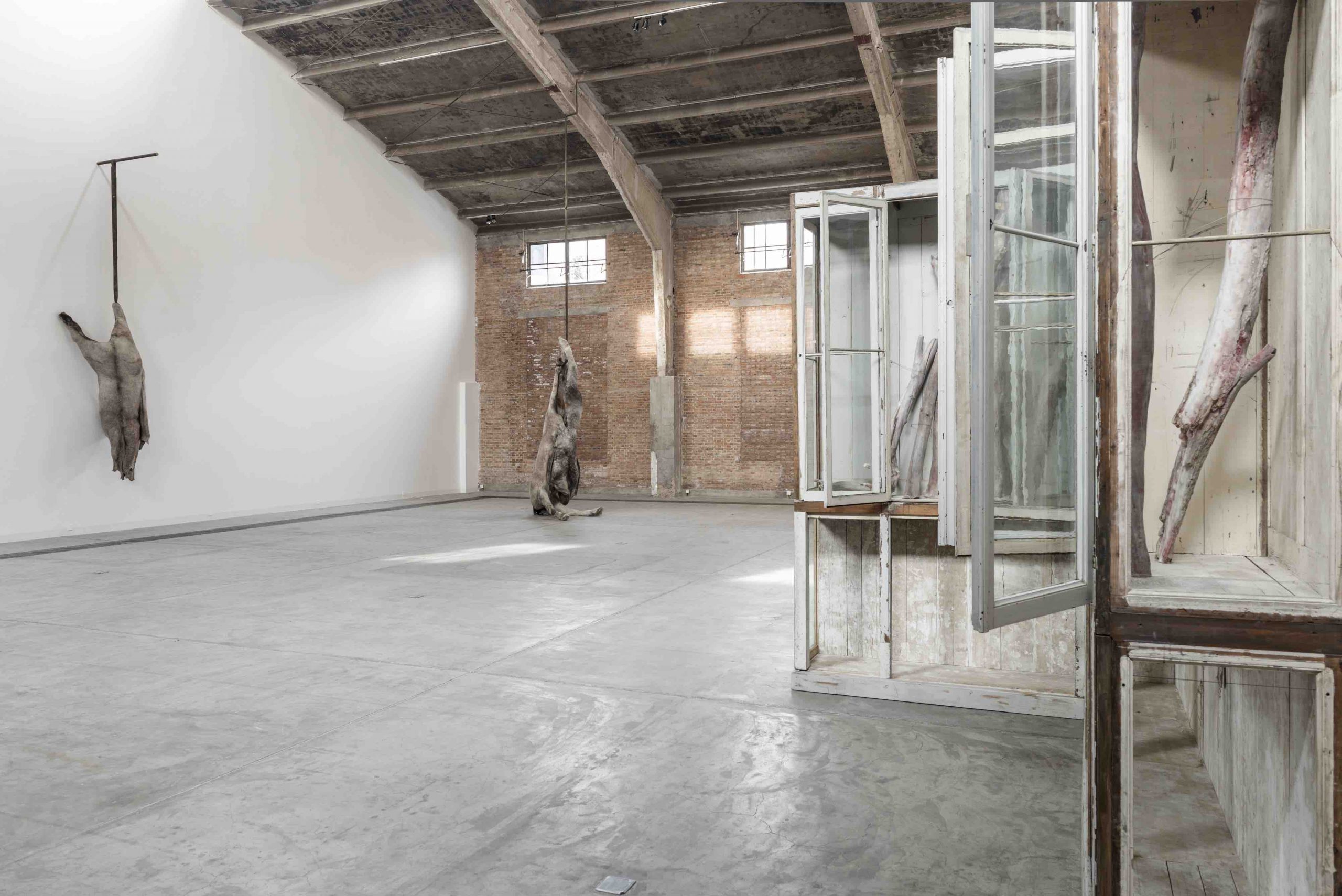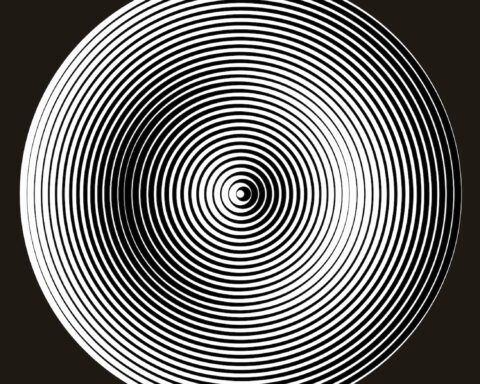We live in a time that is rediscovering sacrifice devoid of sacredness. A time when, more often than not, sacrifice is considered as an unexpected tragedy painfully imposed by a ruinous fate. A drama after the disaster to which we must conform, with which we must deal, as long as is still possible. Undertaking the painful and purifying path of sacrifice is a pact solely for the elect whose destiny is chosen ahead of all the time that will pass. The call is equivalent to coming to terms with oneself before anything else, with one’s being in the world in the first place. It is about trauma and acceptance (a non-passive one, not an instance of endurance). Among the synonyms of acceptance in Italian we find: welcome, meeting but, above all, wax. So what would be the link between the two terms, acceptance and wax? Without great effort it would be enough to think of the extreme malleability of this substance. But there is more.
The word KEROS (wax) in Greek was decomposed into KAIO-burn and REO-flow. The property of the honeycomb of liquefying in contact with heat determines its very naming. Taking guises flowing in a precarious aspect, wax takes in time the shape of time. Unsurprisingly, in Greek KARA also indicates the head, sometimes specifically the face and its outer appearance. Che brutta cera, what a bad look — we usually say in Italian when meeting someone apparently feeling unwell. And the French verb acarier would be equivalent to face-to-face confronting. In Latin, the plural of wax was used to indicate the images of the ancestors, the penates, which were made with beeswax and vegetable waxes.
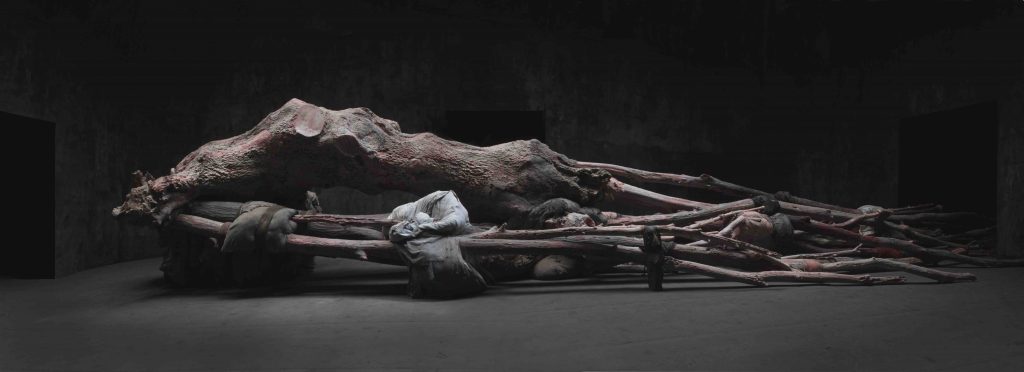
Kreupelhout – Cripplewood, 2012-2013
Courtesy the artist and GALLERIA CONTINUA
Photo Mirjam Devriendt
Venice Biennale, 2013
Fabrizio Ajello: I would start from the mythology that seems to be one of the cornerstones in your work. I am thinking of the evident references to the legends of Apollo and Daphne, to Marsyas, to the continuous metamorphoses present in Greek mythology. How relevant is classic mythology as well as that kind of tales, in broader terms, to your work?
Berlinde De Bruyckere: Yes, the myths of Ovid, the metamorphosis especially is something that I very often refer to in my works. It has always impressed me, this idea of transformation, for which you start from something and you grow into something else like Filemone and Bauci, the beautiful couple who became two different trees (an oak and a lime tree) stood together. These myths have been a great inspiration to me, as well as the Christian icons, like the saint Sebastian for instance, that was a key element in my work for the Belgian Pavilion, Kreupelhout-Cripplewood. Mythology’s protagonists and christian icons have always been starting points that I translated in another language, in my language. In fact, in many cases there is a profound relationship between Greek mythology and Christian icons. It’s easy to find the same topic translated and remodeled in different cultures. The Pietà by Michelangelo, the representation of San Sebastian, the relationship between mother and child, I have had these references since the beginning of my career, then slowly I found the right balance with mythological connections. For example, Saint Bartolomeus and Marsias, both these figures embody the same icon in some ways, but with a different name. So this is a pulsating universe for me and, as human beings, we often refer to stories that elevate us.
F.A.: You were talking about surface and depth, hard and soft, two important dimensions in your work: two, dimensions linked by the touch and by the wound. To tie, for example, is a violent but at the same time protective gesture, it is again a kind of research for the balance between excess and default. But how do you manage to find the “right “balance?
B.B.: When I bring the wax pieces on top of the cushions and blankets, you can feel this duality, whereby something hard is in contact with something soft, or when I take the wax out the silicon mould, it is still warm and fragile so that I can deform it; it’s very dangerous to lay it on the floor, or on the table, and with my staff, we usually lay the pieces of wax on cushions. The relationship between them is perfect, and at the same time it’s quite the opposite visual effect of swaddling the broken branches. I connect broken parts with something soft, textile materials that reassemble, a bit like nurses or surgeons do. It’s in a certain way taking care of, as it would be for a body of a human being. This drives to a tactile perception and, at the same time, to the vibration of colors, from the nuances of the cushions to the darker parts, from the shadows to the brighter parts.
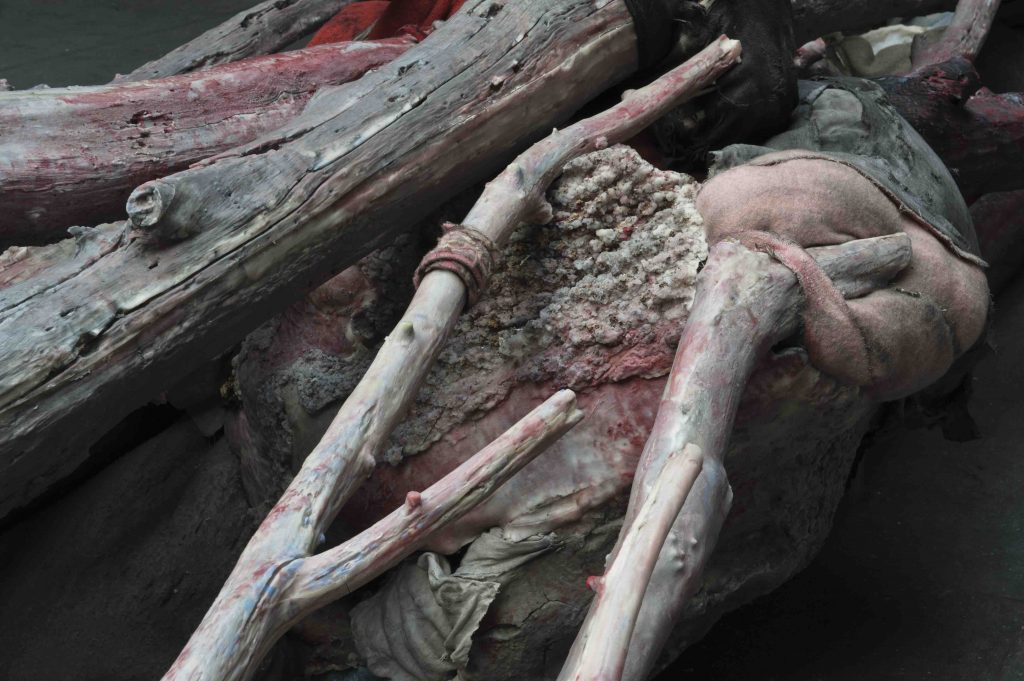
Kreupelhout – Cripplewood, 2012-2013
Courtesy the artist and GALLERIA CONTINUA
Photo Mirjam Devriendt
Venice Biennale, 2013
The symptoms of Berlinde de Bruychere’s artistic research are cached in the remote bowels of language. The carnality of creation. Carnality as a monolith of existence. Osseous, mineral, vegetal, epidermal, textile carnality. Everything is vulnerable, and an invisible unstoppable lifeblood flows within. Yet, everything must make room for itself, get incarnated. Matter thus becomes a bagful of time and a container for the soul. It is the artist herself who often states in interviews that the surface is a container for the soul. In this sense, the skin is a hint at the depth and the beginning of a journey and discovery. What is hidden makes the surface a bridge between the interior and the ever-changing external world. The epidermis of de Bruyckere’s works is not superficial, and appears as a pulsating, iridescent organism where the balance between the parts at play is broken. The dialogue between the internal and the external transmutes both and an osmosis gets going in a blatant fashion, which demands our attention, nails down our gazes and questions them. The challenge to the material opens the image, handles it to the point of exhaustion, pushes it elsewhere. G. Didi Huberman stated: “The incarnation, therefore: a motive, an engine, a desire, a setting in motion that, by additions and subtractions, often pushes the images towards their own boundaries.”
F.A.: The alchemical research in your work has always fascinated me. The elements, the heat, the wax, the skin, the blankets, the wood, the pigment, I mean all the tactile and olfactory qualities, the resistances. And even the decision to leave the blankets that you use in your works, in the garden, as to let nature itself consume and alter them. This reminds me of E. Munch who did the same in his paintings. Is there also a biological and organic care in your modus operandi? A constant research for the balance between macrocosm and microcosm as well?
B.B.: I can give you a good example with the blankets that is a material that I have been using since the Eighties and during that time I was impressed by the presence of existences in the blankets, I didn’t really choose the material for its esthetic qualities, but for the variety of stories that these blankets contained. They had served people in a very intimate way. To use them in my work was in a way giving them a second life. When I was in a flea market to find blankets for my works, I had to choose the most appropriate ones, trying to feel the past of each of them. Some of them I was not interested in, others instead were damaged, or showed defects, so this made me start dreaming and led me to imagine what they could have become. From there on, I began to be interested in colors, and patterns that said something about the period in which they were used. In my work, blankets have always been a constant element but since 2005 blankets have also become a second skin, in some cases in a tone-on-tone relationship with respect to the wax part. There is a clear evolution in the use of blankets in my work. Going back to the early works, the beds, I put hundreds of blankets, one on top of the other and I cut out part of them. This work was related to a parasite, who was eating and beating holes in the most intimate place of our home: the bed. Also layering was and is a constant in my work. In recent years I brought blankets outside my studio for months, sometimes even for years, to change the characters of the blankets. Then, with the passage of time and the intervention of nature, their power to protect and warm disappears. That’s when I bring them back to my studio and hang them. I start cleaning them one by one, and I see the result of nature’s intervention. Layering blanket on blanket it becomes clear how fragile they have become.
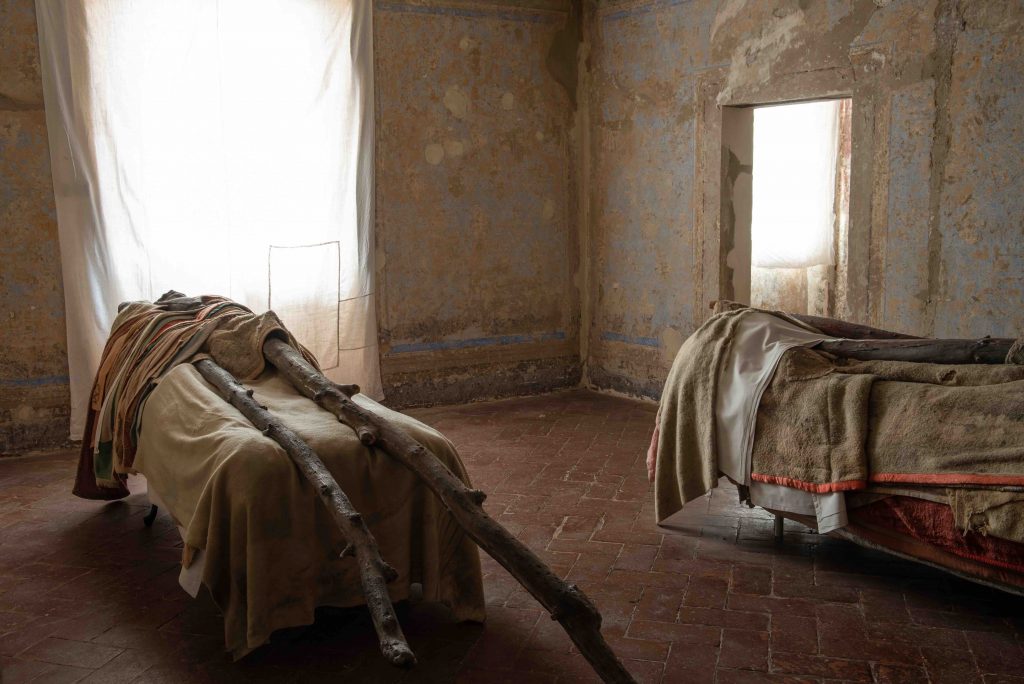
F.A.: Getting goosebumps (in Italian: avere la pelle d’oca) is the first form of art; my Art teacher told me like that, when I was a student in Sicily. Experiencing an emotional reaction before a real understanding, it is, in my opinion, the signal of a strong relationship with something ancestral and radical, sacred in a certain way. Where does everything that inspires and leads us actually come from?
B.B.: My topic from the beginning was the cage. In that period I used to build huge cages of steel, and still I do! When I look back at my Arcangelo today, I can still find the old works inside, even if they are invisible, covered by a blanket. So you may be wondering where all this is coming from, but it’s something not rational, it’s something emotional that comes from my gut, from my heart. We all grew up in a certain atmosphere, the theme of religion was very present in my background and it found its way to my work. When I started working I did not realize it rationally. As an artist you have to accept it and take care of it. Of course, the condition of the human being, death, anger and fear, are hard topics.
Nature, and its overwhelming force is also very important in my work. The tree is a metaphor for the human body. The work Embalmed – Twins for example, was related to Holy Week processions, thinking back to the suffering, the difficulty of carrying the effigies of the saints despite the heat, the weight, I made these double bodies of large trees, and unlike Cripplewood this work is more connected to the essence and quality itself of the skin and the nature of human body.
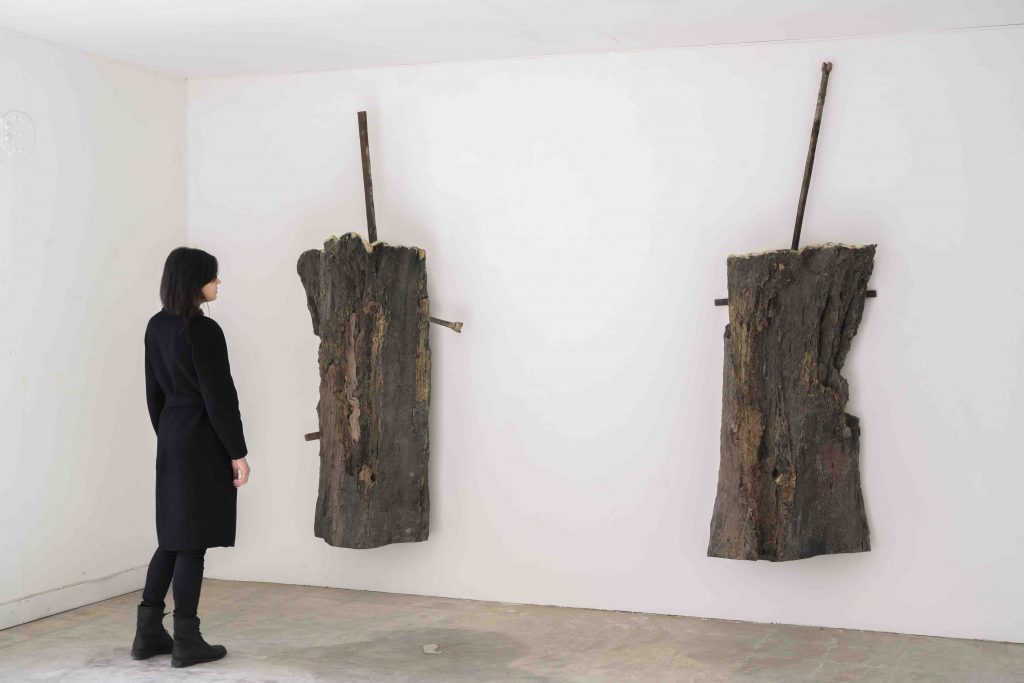
Exhibition view, Galleria Continua, Les Moulins, 2019
Courtesy the artist and GALLERIA CONTINUA
Photo Oak Taylor-Smith
The tree stands out as the protagonist in de Bruyckere’s research. Roots. A canopy of leaves. Leather here too. A torso. Wounds. Corridors of coagulated sap, hollows, dented branches. Francis Bacon stated in an interview that the real challenge for the art of the future was not about taking a tree and exhibiting it in a gallery, but about being able to find a way of representing it not as a mere reproduction but as an accomplished image affecting one’s nervous system. In this sense, the Belgian artist’s research perfectly blends the emotional impact of the wound and the imperturbability of a monolith. Suddenly a panic icon appears from the bottom, a supreme deposition of the entire Creation. The definitive vision that liberates time from its tyrannical flow. If the Italian artist Giuseppe Penone achieves a poetic aestheticization of the tree, digging into it, revealing its veins, gilding the unconcealed voids, de Bruyckere burdens the vegetal body with a full payload to reveal its dramatic destiny. The ultimate fallen angel. The refined and embellished bark on one side, the inexorable and ruinous shipwreck on the other. The contortion and impenetrability of Nature, here extremely evident, are a metaphor for the absolute weight of the human condition: the entire planet is made of flesh and bones, which we still carry.
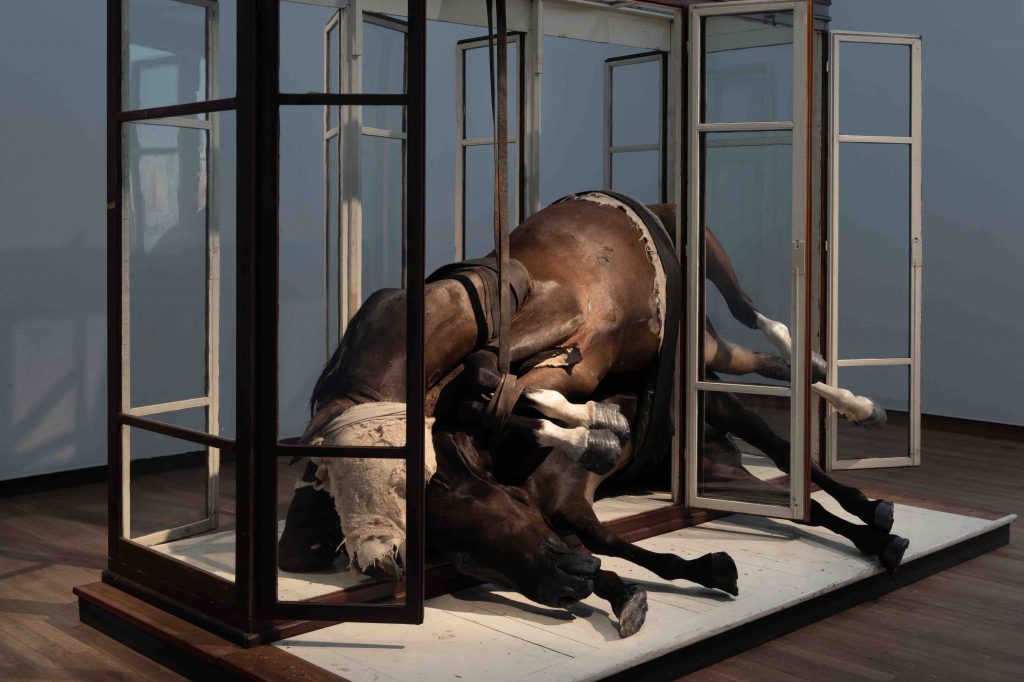
Berlinde De Bruyckere Engelenkeel exhibition view, 2021
Bonnefanten, Maastricht
Courtesy the artist and GALLERIA CONTINUA
Photo Mirjam Devriendt


